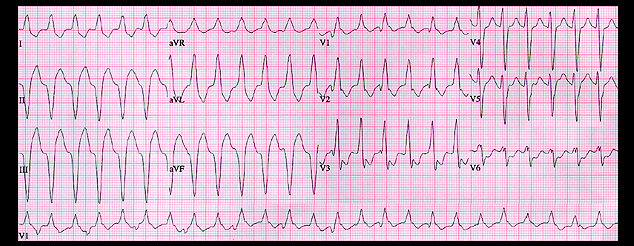
[INSERT ARROWS SHOWING THE P WAVES IN LEAD V1 IF POSSIBLE} This wide QRS complex tachycardia (rate 150) displays many of the criteria for ventricular tachycardia discussed in chapter 7 (see pages 7.4.27-7.4.30). The QRS complex is 0.150 seconds (150 msec) in duration, with right bundle branch block and left axis deviation (-75 degrees). The QRS complex in leads V1 is entirely upright and there is an r/S complex in V6 (the R to S ratio is less than 1). The most compelling evidence for the diagnosis of ventricular tachycardia is the presence of P waves that are dissociated from the QRS complexes, i.e. AV dissociation. These are best seen in lead V1 (arrows). The PP interval is 0.82 seconds, indicating an atrial rate of 73. Note that two of the criteria employed by Brugada et al are not present. These are: 1) the absence of an RS complex in all precordial leads and 2) an interval equal to or greater than 100msec from the onset of the R wave to the nadir of the S wave in any precordial lead.
